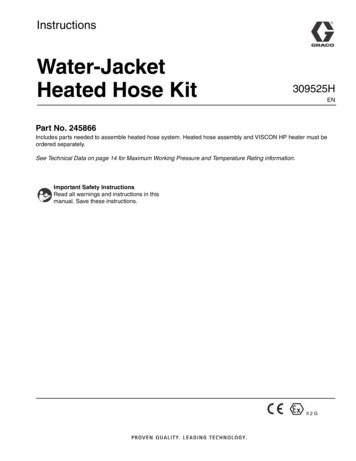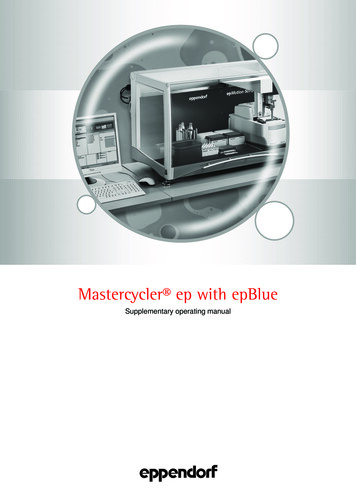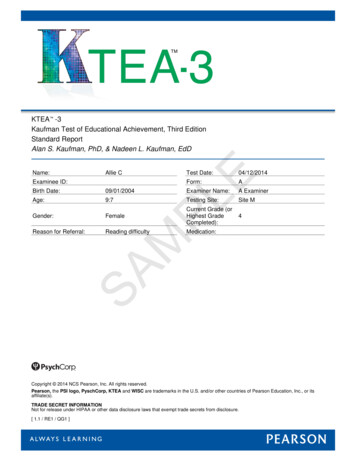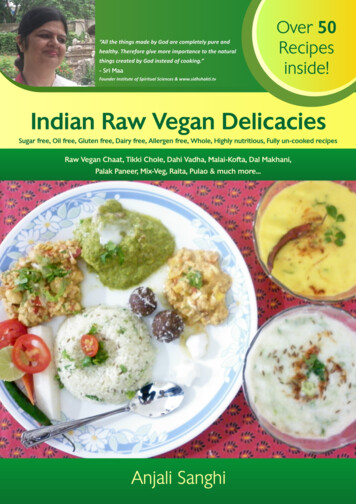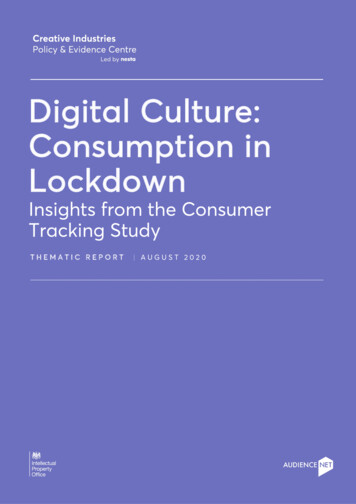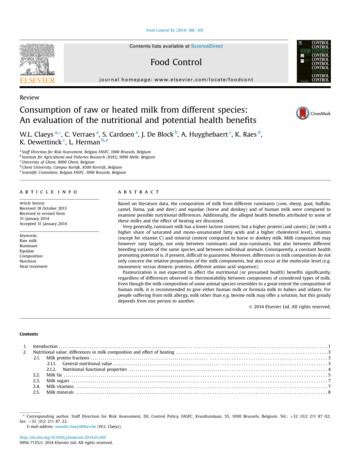
Transcription
Food Control 42 (2014) 188e201Contents lists available at ScienceDirectFood Controljournal homepage: www.elsevier.com/locate/foodcontReviewConsumption of raw or heated milk from different species:An evaluation of the nutritional and potential health benefitsW.L. Claeys a, *, C. Verraes a, S. Cardoen a, J. De Block b, A. Huyghebaert c, K. Raes d,K. Dewettinck c, L. Herman b, eaStaff Direction for Risk Assessment, Belgian FASFC, 1000 Brussels, BelgiumInstitute for Agricultural and Fisheries Research (ILVO), 9090 Melle, BelgiumUniversity of Ghent, 9000 Ghent, BelgiumdGhent University, Campus Kortijk, 8500 Kortrijk, BelgiumeScientific Committee, Belgian FASFC, 1000 Brussels, Belgiumbca r t i c l e i n f oa b s t r a c tArticle history:Received 18 October 2013Received in revised form31 January 2014Accepted 31 January 2014Based on literature data, the composition of milk from different ruminants (cow, sheep, goat, buffalo,camel, llama, yak and deer) and equidae (horse and donkey) and of human milk were compared toexamine possible nutritional differences. Additionally, the alleged health benefits attributed to some ofthese milks and the effect of heating are discussed.Very generally, ruminant milk has a lower lactose content, but a higher protein (and casein), fat (with ahigher share of saturated and mono-unsaturated fatty acids and a higher cholesterol level), vitamin(except for vitamin C) and mineral content compared to horse or donkey milk. Milk composition mayhowever vary largely, not only between ruminants and non-ruminants, but also between differentbreeding variants of the same species and between individual animals. Consequently, a constant healthpromoting potential is, if present, difficult to guarantee. Moreover, differences in milk composition do notonly concern the relative proportions of the milk components, but also occur at the molecular level (e.g.monomeric versus dimeric proteins, different amino acid sequence).Pasteurization is not expected to affect the nutritional (or presumed health) benefits significantly,regardless of differences observed in thermostability between components of considered types of milk.Even though the milk composition of some animal species resembles to a great extent the composition ofhuman milk, it is recommended to give either human milk or formula milk to babies and infants. Forpeople suffering from milk allergy, milk other than e.g. bovine milk may offer a solution, but this greatlydepends from one person to another.Ó 2014 Elsevier Ltd. All rights reserved.Keywords:Raw milkRuminantEquidaeCompositionNutritionHeat treatmentContents1.2.Introduction . . . . . . . . . . . . . . . . . . . . . . . . . . . . . . . . . . . . . . . . . . . . . . . . . . . . . . . . . . . . . . . . . . . . . . . . . . . . . . . . . . . . . . . . . . . . . . . . . . . . . . . . . . . . . . . . . . . . . . . . .1Nutritional value: differences in milk composition and effect of heating . . . . . . . . . . . . . . . . . . . . . . . . . . . . . . . . . . . . . . . . . . . . . . . . . . . . . . . . . . . . . . . . . . . .32.1.Milk protein fractions . . . . . . . . . . . . . . . . . . . . . . . . . . . . . . . . . . . . . . . . . . . . . . . . . . . . . . . . . . . . . . . . . . . . . . . . . . . . . . . . . . . . . . . . . . . . . . . . . . . . . . . . . . 32.1.1.General nutritional value . . . . . . . . . . . . . . . . . . . . . . . . . . . . . . . . . . . . . . . . . . . . . . . . . . . . . . . . . . . . . . . . . . . . . . . . . . . . . . . . . . . . . . . . . . . . . . . . 32.1.2.Nutritional functional properties . . . . . . . . . . . . . . . . . . . . . . . . . . . . . . . . . . . . . . . . . . . . . . . . . . . . . . . . . . . . . . . . . . . . . . . . . . . . . . . . . . . . . . . . . 42.2.Milk fat . . . . . . . . . . . . . . . . . . . . . . . . . . . . . . . . . . . . . . . . . . . . . . . . . . . . . . . . . . . . . . . . . . . . . . . . . . . . . . . . . . . . . . . . . . . . . . . . . . . . . . . . . . . . . . . . . . . . . . . 52.3.Milk sugars . . . . . . . . . . . . . . . . . . . . . . . . . . . . . . . . . . . . . . . . . . . . . . . . . . . . . . . . . . . . . . . . . . . . . . . . . . . . . . . . . . . . . . . . . . . . . . . . . . . . . . . . . . . . . . . . . . . 72.4.Milk vitamins . . . . . . . . . . . . . . . . . . . . . . . . . . . . . . . . . . . . . . . . . . . . . . . . . . . . . . . . . . . . . . . . . . . . . . . . . . . . . . . . . . . . . . . . . . . . . . . . . . . . . . . . . . . . . . . . . 72.5.Milk minerals . . . . . . . . . . . . . . . . . . . . . . . . . . . . . . . . . . . . . . . . . . . . . . . . . . . . . . . . . . . . . . . . . . . . . . . . . . . . . . . . . . . . . . . . . . . . . . . . . . . . . . . . . . . . . . . . . 8* Corresponding author. Staff Direction for Risk Assessment, DG Control Policy, FASFC, Kruidtuinlaan, 55, 1000 Brussels, Belgium. Tel.: þ32 (0)2 211 87 02;fax: þ32 (0)2 211 87 22.E-mail address: wendie.claeys@favv.be (W.L. 01.0450956-7135/Ó 2014 Elsevier Ltd. All rights reserved.
W.L. Claeys et al. / Food Control 42 (2014) 188e2013.4.5.6.7.189Antimicrobial systems . . . . . . . . . . . . . . . . . . . . . . . . . . . . . . . . . . . . . . . . . . . . . . . . . . . . . . . . . . . . . . . . . . . . . . . . . . . . . . . . . . . . . . . . . . . . . . . . . . . . . . . . . . . . . . . .9Milk digestibility . . . . . . . . . . . . . . . . . . . . . . . . . . . . . . . . . . . . . . . . . . . . . . . . . . . . . . . . . . . . . . . . . . . . . . . . . . . . . . . . . . . . . . . . . . . . . . . . . . . . . . . . . . . . . . . . . . . .9Milk allergy & lactose intolerance . . . . . . . . . . . . . . . . . . . . . . . . . . . . . . . . . . . . . . . . . . . . . . . . . . . . . . . . . . . . . . . . . . . . . . . . . . . . . . . . . . . . . . . . . . . . . . . . . . . . .10Infant nutrition . . . . . . . . . . . . . . . . . . . . . . . . . . . . . . . . . . . . . . . . . . . . . . . . . . . . . . . . . . . . . . . . . . . . . . . . . . . . . . . . . . . . . . . . . . . . . . . . . . . . . . . . . . . . . . . . . . . . .10Conclusions . . . . . . . . . . . . . . . . . . . . . . . . . . . . . . . . . . . . . . . . . . . . . . . . . . . . . . . . . . . . . . . . . . . . . . . . . . . . . . . . . . . . . . . . . . . . . . . . . . . . . . . . . . . . . . . . . . . . . . . .10Conflict of interest . . . . . . . . . . . . . . . . . . . . . . . . . . . . . . . . . . . . . . . . . . . . . . . . . . . . . . . . . . . . . . . . . . . . . . . . . . . . . . . . . . . . . . . . . . . . . . . . . . . . . . . . . . . . . . . . . . . 11Acknowledgment . . . . . . . . . . . . . . . . . . . . . . . . . . . . . . . . . . . . . . . . . . . . . . . . . . . . . . . . . . . . . . . . . . . . . . . . . . . . . . . . . . . . . . . . . . . . . . . . . . . . . . . . . . . . . . . . . . . 11References . . . . . . . . . . . . . . . . . . . . . . . . . . . . . . . . . . . . . . . . . . . . . . . . . . . . . . . . . . . . . . . . . . . . . . . . . . . . . . . . . . . . . . . . . . . . . . . . . . . . . . . . . . . . . . . . . . . . . . . . . 111. IntroductionBovine milk is by far the most commonly consumed type ofmilk, dominating global milk production. However, in certain partsof the world and local contexts, milk from other animal species hasa significant share in milk consumption as well. Apart from bovinemilk (representing 85% of milk produced worldwide), the worldwide milk production is highest for buffalo milk (11%), followed bygoat (2.3%), sheep (1.4%) and camel milk (0.2%) (Gerosa & Skoet,2012 , p. 40). For other animal species, such as horses and donkeys and yaks, no world statistics are available, but their contribution to the global milk production is less than 0.1%. Additionally,a marginal production of reindeer and llama milk is reported inliterature, and even some wild species, such as zebra or eland, aredescribed as potential dairy animals (Faye & Konuspayeva, 2012).These alternative milks, horse and donkey milk in particular,seem to experience a revival in continental Europe with e.g. newhorse dairies in Belgium, France, the Netherlands and Norway(Marchand, Merchiers, Messens, Coudijzer, & De Block, 2009;Uniacke-Lowe, 2011). A number of cosmetic, but also some therapeutic properties (e.g. for treating metabolic, gastrointestinal andliver problems, for curing or preventing atherosclerosis, arthritisand cancer) are attributed to these milks. However, ascribing suchproperties to milk of a given species not only requires a confirmation of a causal relationship, but also the guarantee that theresponsible or active components are present at sufficiently highamounts, irrespectively of external factors. Whereas bovine milk isproduced on an industrial scale and as such mostly standardizedwith respect to fat and protein content, equine milk or milk fromother species is usually produced on a local scale and showconsequently a higher variability in composition due to differencesin breed, feeding regime, etc.Another aspect, is the increasing popularity and the promotionof raw milk as “health food”. Besides a detrimental effect of heatingon the beneficial health effects of milk, the most frequently citedarguments of raw milk advocates are a reduced susceptibility toallergies, a higher nutritional quality and a better taste. However,the consumption of raw milk poses a realistic microbiological riskfor the consumer. The presence of foodborne pathogens has beendemonstrated in many surveys and foodborne infections have beenrepeatedly reported for Campylobacter, Salmonella spp. and humanpathogenic verocytotoxin-producing Escherichia coli after raw milkconsumption (Claeys et al., 2013; O’Mahony, Fanning, & Whyte,2009; Robinson, Scheftel, & Smith, 2013; Verraes et al., in press).The first aim of the present study is to list the compositions ofmilk of different species and to discuss their nutritional values.Given that some milks (e.g. horse, donkey and sheep milk) arepromoted as a suitable alternative to breast milk and infant formula, a comparison is also made with human milk. Furthermore,the putative health promoting potential of some milk compoundsas well as the effect of heating (mainly of pasteurization) on severalmilk parameters that could be of interest in terms of humannutrition are addressed.2. Nutritional value: differences in milk composition andeffect of heatingMilk of all mammals contains the same principal components,namely water, proteins, fats, carbohydrates, vitamins and minerals,but their content varies widely between ruminant and nonruminant milk (Table 1). Even between various (non-)ruminantsand within a same species the milk composition may differconsiderably, given the influence of genetic factors (not only atspecies but also at breed level), physiological factors (e.g. lactationstage, milking interval), nutritional factors (e.g. feed energy valueand composition) and environmental conditions (e.g. location,season). The values presented in this paper should therefore not beviewed as absolute but rather as indicative for the concentrationrange of milk components. Moreover, methodological differencesregarding data collection between consulted papers may contributeto the spread of the presented values.2.1. Milk protein fractions2.1.1. General nutritional valueIn general, a distinction is made between “casein” milk (i.e.ruminant milk which is relatively rich in casein) and “albumin”milk (i.e. non-ruminant milk which has proportionally a higherwhey protein content as indicated by the lower casein/whey ratio)(Table 1). The casein fraction represents around 80% of bovine andsheep milk proteins, roughly 50% of horse milk proteins and lessthan 50% of human milk proteins (Malacarne, Martuzzi, Summer, &Mariani, 2002; Park, Juárez, Ramos, & Haenlein, 2007; Poto cnik,Gantner, Kuterovac, & Cividini, 2011). As can be seen fromTable 2, the relative proportion of the main milk casein componentsdiffer, not only between ruminants and non-ruminants, but alsobetween ruminant species. Given these different relative proportions, casein micelle characteristics differ as well, in size but alsoin hydration and mineralization. For instance, sheep and goatcasein micelles have on average higher mineralization levels, andare less hydrated, less solvated, and less heat stable than bovinecasein micelles (Park et al., 2007). Moreover, the molecular formand amino acid sequence of the milk proteins may differ from onespecies to another (e.g. at neutral pH b-lg is present as monomer inhorse milk, but as dimer in ruminant milk; Salimei & Fantuz, 2012),which additionally affects the protein digestibility, nutritionalquality and thermostability.The nutritional value of milk proteins depends to a great extenton the presence of essential amino acids. A comparison betweendifferent species is given in Table 3. When expressed in terms of100 g protein, differences observed in milk amino acid levels between different species are small and seem to be most likely relatedto differences in total protein content (Guo et al., 2007).As to the thermal stability of milk proteins, differences betweenspecies are mainly due to differences in amino acid sequence (andnumber of SeS bridges or sulphydryl groups) and in milk environment (e.g. slightly different pH, fat content). For example,
190W.L. Claeys et al. / Food Control 42 (2014) 188e201Table 1Gross composition of mature milk from different mammals.aHumanTotal dry matter (g/l)Proteins (g/l)Casein/whey ratioFat (g/l)Lactose (g/l)Ash (g/l)Energy 201e27175e130w4e5102e21512e4712e275541e8436aBased on minimal and maximal values found in literature; in some of the references no specification was given regarding the postpartum period or lactation stage.Sources: Arman, Kay, Goodall, & Sharman, 1974; Guo et al., 2007; Hassan et al., 2009; Malacarne et al., 2002; Medhammar et al., 2012; Mittaine, 1962; Naert et al., 2013; Parket al., 2007; Poto cnik et al., 2011; Salimei & Fantuz, 2012; Shamsia, 2009; Souci, Fachmann, & Kraut, 2008 , p. 1464; Uniacke-Lowe, 2011 , chap. 1 & 2; Xi, Li, & Gao, 2010.lactoferrin and serum albumin have a similar thermostability inbovine and horse milk, whereas b-lg and a-lactalbumin have ahigher thermostability in horse compared to bovine milk. The highthermal stability of equine b-lg may be related to its monomericform and the lack of a free SH group (Bonomi, Iametti, Pagliarini, &Solaroli, 1994; Uniacke-Lowe, Huppertz, & Fox, 2010). Whey proteins of bovine milk are less resistant to heat denaturationcompared to those of buffalo milk (Jainudeen, 2002), which in turnare less heat resistant than camel whey proteins (El-Agamy, 2000;Hassan, Farahat, & Abd El-Gawad, 2009). Even though camel wheyproteins have a higher heat stability than bovine whey proteins attemperatures between 63 and 90 C (Farah, 1986), bovine milkcoagulates much slower at higher temperatures. This could berelated to the absence or very low levels of b-lg and k-casein incamel milk (Farah & Atkins, 1992) as milk is more resistant to heatwhen it is characterized by a molar b-lg to k-casein ratio close to 1 czuk, & Król, 2011).(Bar1owska, Szwajowska, Litwin2.1.2. Nutritional functional propertiesMilk contains a large number of enzymes, secreted by the mammary gland or of microbial origin, but their biological function ismostly unknown. Given the limited amount of data together withdifferences in measurement techniques (e.g. use of different substrates), only a qualitative comparison between different species formerely a number of enzymes is possible. Alkaline phosphatase (ALP),a thermal indicator for bovine milk pasteurization, is present in milkfrom all mammals. However, due to differences in activity (e.g. lowerin goat milk and 35 to 350 times lower in horse milk, but higher insheep milk compared to bovine milk) and thermal inactivation rate(e.g. slower in goat and sheep milk and faster in horse milk comparedto bovine milk), the negative ALP test to assess the efficacy ofpasteurization does not seem to be universally applicable (Lorenzen,Martin, Clawin-Rädecker, Barth, & Knappstein, 2010; Marchand et al.,2009; Raynal-Ljutovac, Park, Gaucheron, & Bouhallab, 2007;Tziboula-Clarke, 2002; Vamvakaki, Zoidou, Moatsou, Bokari, & Anifantakis, 2006). Xanthine oxidoreductase (XOR) is a major protein ofthe milk fat globule membrane and may play an antimicrobialdefensive role in the neonatal gut, complementing endogenousenzyme of the intestinal epithelium (Harrison, 2006). Its activity isrelatively high in bovine milk compared to milk from other species(e.g. goat, sheep, camel and human milk), of which the XORs arelargely deficient in molybdenum (Mo), necessary for catalytic activity(e.g. up to 98% of the molecules in human milk lack Mo) (Fox & Kelly,2006; Tziboula-Clarke, 2002; Uniacke-Lowe, 2011). Plasmin, a proteolytic enzyme, is reported to have a higher activity in horse milkcompared to bovine milk. The lipolytic activity on the other hand, issimilar in horse, bovine and buffalo milk, but lower in goat and human milk (Shakeel-ur-Rehman & Farkye, 2002; Uniacke-Lowe, 2011).Other milk protein fractions that are linked to beneficial healtheffects, include immunoglobulins and growth factors. The mainfunction of immunoglobulins (Igs) is to protect the newbornagainst infections. Their content is mainly high in colostrum anddrops significantly during lactation (El-Agamy, 2000; Griffiths,2010 p. 520; Korhonen, 2009; Pandya & Haenlein, 2009; Zagorska& Ciprovica, 2012). Horse milk, but particularly buffalo, camel andllama milk have a higher Ig content compared to bovine, sheep,goat and human milk (Table 2) (Bravo, Garnica, & Fowler, 1997;Pandya & Haenlein, 2009). The relative Ig ratios differ as well. Forexample, IgG is predominant in horse colostrum and in both bovinemilk and colostrum, but IgA is the major Ig in mature horse milkand in human milk and colostrum (Elfstrand, Lindmark-Månsson,Paulsson, Nyberg, & Ǻkesson, 2002; Uniacke-Lowe, 2011; Zagorska & Ciprovica, 2012).During high temperature/short time (HTST) pasteurization(72 C/15 s) only 10 to 30% of bovine milk Ig activity is lost, whereasultrahigh temperature (UHT) treatment (138 C/4 s) destroys themajority of the specific immune activity of milk. It is however,difficult to determine Ig heat losses accurately or to compare theheat induced Ig losses between different species since chemicalcomposition, pH and other milk factors affect Ig levels duringthermal treatment. In general, studies suggest that the antigenbinding region of the Ig molecule is more thermolabile than theother molecule regions, and that IgG is the most and IgM the leastthermostable (Elfstrand et al., 2002; Uniacke-Lowe, 2011; Zagorska& Ciprovica, 2012).Growth factors (GF), such as epidermal (EGF), insulin-like (IGF-1and -2), transforming (TGF-b1 and TGF-b2) and fibroblast (FGF-1and -2) growth factors, play a role in growth and development andare present in the blood, the milk, the eggs and most tissues of themajority of animal species. Some growth factors are also discussedas health-impairing factor. For example, a positive correlation hasbeen observed between IGF-1 blood levels and prostate, breast andcolorectal cancer risk, but more research is needed on a possibleassociation between exogenous GF intake (e.g. from milk or dairyproducts) and GF blood levels or cancer risk (Anses, 2012). Availabledata on the GF content in milk concern mainly bovine and humanmilk (Table 2). The GF content of milk not only depends on theanimal species, but also on the lactation period, the time of milkingand the number of parturitions (Anses, 2012; Odle, Zijlstra, &Donovan, 1996; Park, 2009). Similarly to Igs, GF preserve someactivity after pasteurization, but are almost completely inactivatedafter UHT treatment. GF are not only inactivated by heating, butalso during storage and the various stages of digestion (Anses,2012; Elfstrand et al., 2002). Based on available data for IGF-1, itis presumed that if GF of dairy origin would enter the bloodstream,the amount would be too low compared to the circulating andendogenously produced amounts of GF (Anses 2012).In contrast to the total amino acid composition, which is basically similar between species (Table 3), the composition of freeamino acids (FAA) varies considerably. Human milk e.g., has a FAA
Table 2Protein fractions (g/l) of mature milk from different 6l0me29.6l2.8e13.4l( .431.300.8l100 10-60.7p0.02e0.2250 .4(120e152) x 10 610.660.37e1.340.01e0.040.04e1.915.9e8.1( 7.03.2e3.31.2e1.30.3e0.40.8e1.20.02e0.5(70e600) x 10 7e2.3lSerum albuminProteose ulins (Ig) sein/whey 4e0.289350.08e0.60.8e5.3w811NPNfPutrescine (mmol/l)Spermidine (mmol/l)Spermine (mmol/l)CMPg (mmol/l)UMPh (mmol/l)GMPi (mmol/l)AMPj 4e17.71.0e3.31.4e33.40.38Sourcesb, d, e, h, i, k, m, q, r a, b, d, h, p, q, x, z d, h, i, k, q, r b, d, e, h, i, k, l, m, n, q, r, v, x d, e, g, i, q, r, x b, d, e, i, n, q, r, t, u, x c, d, m, q, v, abTotal Casein micel (nm)Total whey proteinsb-Lactoglobulina-LactalbuminGrowth factors (GF)EGFb (mg/l)IGF-1c (mg/l)IGF-2c (mg/l)TGF-ad (mg/l)TGF-bd (mg/l)TGF-b1d (mg/l)TGF-b2d (mg/l)FGF-1e (mg/l)FGF-2e 73.1 2e155 2e101w2e117w0.14.30.21e3.70e710.020.5e1 -8.3Traces-53.8LlamaYak(Rein)deer34.3e45.8 70e809.3e13.13.6e6.515.0e20.64.9e8.513.4( )q3.4e10.10.2e1.70.2e3.10.02e7.28( )r(60e1350) x 10 50.4e0.52.2d, k, o, q, s, vw, yf, jaa, .5e110.0W.L. Claeys et al. / Food Control 42 (2014) 188e201Horsea: Naert et al., 2013; b: Anses, 2012; c: Abd El-Salam & El-Shibiny, 2011; d: Bar1owska et al., 2011; e: Bernacka, 2011; f: Li et al., 2011; g: Poto cnik et al., 2011; h: Uniacke-Lowe, 2011 , chap. 1 & 2; i: La Torre et al., 2010; j: Li et al.,2010; k: El-Agamy, 2009; l: Korhonen, 2009; m: Pandya & Haenlein, 2009; n: Park, 2009; o: Shamsia, 2009; p: Sheng & Fang, 2009; q: Benkerroum, 2008; r: Michaelidou, 2008; s: El-Hatmi, Girardet, Gaillard, Yahyaoui, & Attia,2007; t: Park et al., 2007; u: Tziboula-Clarke, 2002; v: El-Agamy, 2000; w: Bravo et al., 1997; x: Odle et al., 1996; y: Morin, Rowan, Hurley, et al., 1995; z: Murray, Schaudies, & Cavey, 1992; aa: Arman et al., 1974; ab: Mittaine,1962.aBased on minimal and maximal values found in literature; in some of the references no specification was given regarding the postpartum period or lactation stage.bEGF ¼ epidermal GF.cIGF ¼ insulin-like GF.dTGF ¼ transforming GF.eFGF ¼ fibroblast GF.191
W.L. Claeys et al. / Food Control 42 (2014) 188e201rsqopnlmkijhfgNPN ¼ non-protein nitrogen fraction.CMP ¼ cytidyl-50 -monophosphate.UMP ¼ uridyl-50 -monophosphate.GMP ¼ guanosyl-50 -monophosphate.AMP ¼ adenosyl-50 -monophosphate.The presence of k-casein in horse milk was for several years subject to discussion; some authors reported k-casein to be absent whereas others found low levels.Based on percentage.Absence of b- or as1-casein in milk from animals carrying the respective null alleles.Camel milk contains probably too little k-casein to be detectable, andThe presence of b-lactoglobulin in camel milk is subject to discussion (Farah & Atkins, 1992).In skimmed milk.Was not detected.Llama milk is reported to have a higher lactoferrin level than to cow milk (Morin, Rowan, Hurley, et al., 1995).Converted from mg/l.192content of 3020 mmol/l compared to 578 mmol/l in bovine and1960 mmol/l in horse milk (Uniacke-Lowe et al., 2010). FAA, whichare more easily absorbed than protein-bound amino acids, mainlyconsist of the non-essential amino acids glutamate, glycine,aspartate and alanine (Park et al., 2007). Glutamate and glutamineare a source of a-ketoglutaric acid in the citric acid cycle and alsoact as neurotransmitters in the brain (Agostini, Carratù, Boniglia,Riva, & Sanzini, 2000; Uniacke-Lowe et al., 2010). The content offree glutamate and glutamine is respectively around 1184 and285 mmol/l in human milk, 568 and 485 mmol/l in horse milk, and117 and 12 mmol/l in bovine milk (Uniacke-Lowe et al., 2010). TheFAA taurine (an aminosulfonic acid derived from methionine andcysteine, and in strict sense no amino acid) and carnitine (synthesized from lysine and methionine), do not occur as protein-boundamino acids. Taurine and carnitine are essential nutrients fornewborns due to their insufficient endogenous synthesis. Taurinemay act as a membrane stabilizer and growth modulator, and playsa role in the formation of bile acids, which facilitate lipid digestionand absorption. Human milk contains significantly more taurine(300 mmol/l) compared to sheep (140 mmol/l), horse (30 mmol/l) orbovine milk (10 mmol/l) (Park et al., 2007; Uniacke-Lowe et al.,2010). The level of carnitine, which plays an important role in fattyacid transport, ketogenesis and thermogenesis, is, on the otherhand, higher in bovine compared to human milk (160e200 vs. 30e80 mmol/l) (Park, 2009).The FAA represent 10e20% of the milk non-protein nitrogen(NPN) fraction. The NPN fraction consists furthermore mainly ofurea, peptides and ammonium. Additionally, the NPN fraction includes some polyamines and nucleotides that can supplement thehuman biosynthesis (e.g. during growth when the need of childrenfor polyamines is higher). Bovine milk has on average a smaller NPNfraction than human, horse, donkey or goat milk (Table 2). Similarly,milk polyamine and nucleotide levels differ significantly betweenspecies, but also between breeds of the same species (La Torre,Saitta, Potortí, Di Bella, & Dugo, 2010). Upon heating, cytidine andguanine levels increase, whereas the adenosine level decreases.This is mainly related to an increased catalytic activity of milkadenosine deaminase and of ALP at lower heating temperatures,followed by hydrolysis of the nucleotide phosphate group(Schlimme, Martin, & Tait, 2002).2.2. Milk fatThe fat content of donkey and horse milk is remarkably lowerthan the fat content of human and ruminant milk, which is alsoreflected by their calorific value (Table 1). Milk from reindeer andother deer species is in particular characterized by a high fatcontent. Horse and donkey milk fat consist for 80e85% of triglycerides, for 9.5% of free fatty acids and for 5e10% of phospholipids. Bovine, sheep, goat and human milk fat consist for 97e98%of triglycerides, but have only low levels of phospholipids (0.5e1.5%) and free fatty acids (0.7e1.5%) (Doreau & Martin-Rosset,2002; Jensen, Ferris, Lammi-Keefe, & Henderson, 1990; Malacarne et al., 2002; Park et al., 2007; Uniacke-Lowe, 2011).Compared to ruminants, horse and donkey milk fat contain ahigher percentage of polyunsaturated fatty acids (PUFA) and (to alesser extent) a lower percentage of saturated fatty acids (SFA) andmonounsaturated fatty acids (MUFA) (Table 4). In absolute values,donkey milk contains on average 1.69 g/l PUFA, 5.46 g/l SFA and1.96 g/l MUFA compared to respectively 5.78, 15.2 and 16.9 g/l inhuman milk and 1.31, 25.8 and 9.2 g/l in bovine milk (Gastaldiet al., 2010). The fatty acids of horse and donkey milk are mainlyunsaturated or short-chained, which is interesting from a nutritional point of view. For example, horse milk contains about 10times more caprylic acid (C8:0), 3 times more capric acid (C10:0) and
W.L. Claeys et al. / Food Control 42 (2014) 188e201193Table 3Amino acid distribution of mature milk from different species (expressed as mg/100 g 292460971909271466471144606Non-essential amino tial amino acidsAmino 4107338781680547222276691459014,998Protein content(g/100 g milk)Essential amino nylalanineThreonineTryptophanValine5581854aIn some of the references no specification was given regarding the postpartum period or lactatio
W.L. Claeys et al. / Food Control 42 (2014) 188e201 189. lactoferrin and serum albumin have a similar thermostability in bovine and horse milk, whereas b-lg and a-lactalbumin have a higher thermostability in horse compared to bovine milk. The high thermal stability of equine b-lg may be related to its monomeric
